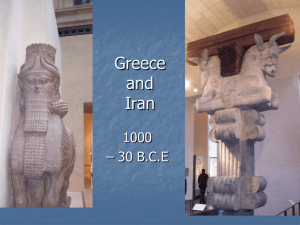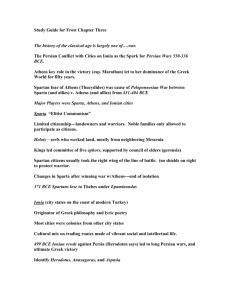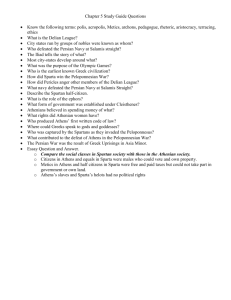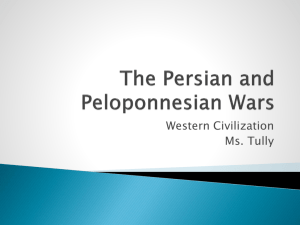The Persian Wars: From the Ionian Revolt to Eion
advertisement
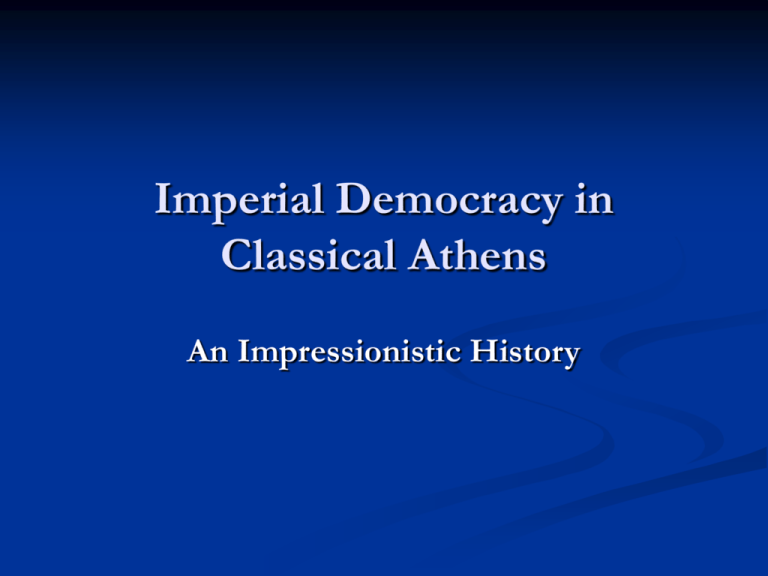
Imperial Democracy in Classical Athens An Impressionistic History Persian Wars 499-479 BCE “So, as it stands now, a man who declares that the Athenians were the saviors of Greece would hit the very truth.” ~ Herodotus, 7.139 Achaemenid Persian Empire Apadana Staircase Persepolis Xerxes’ Gate Persepolis Darius’ Empire Ionian Revolt (499/8-494 BCE) Asia Minor Greeks as part of Yauana Satrapy The Burning of Sardis and Athenian Naval Support (Herodotus 5.105) Darius and the Burning of Sardis Herodotus, 5.105 “When King Darius was informed that Sardis had been captured and burned by the Athenians and the Ionians…he first (so the story goes), when he heard the news, made no account of the Ionians--for he knew well that they would surely not get off scot-free for their rebellion--but he put the question, “Who are the Athenians?” and, having his answer, asked for a bow. He took it, fitted an arrow to it, and shot it into the sky, and as he sent it up he prayed, “Zeus, grant me the chance of punishing the Athenians.” Having said that, he ordered one of his servants that, as often as a meal was set before him, the man should says three times, ‘Master, remember the Athenians’.” First Persian Expedition Against Greece: Battle at Marathon (490 BCE) Modern estimations of the size of the Persian expedition around 20,000 troops Darius attempts to form “fifth columns” among the aristocracies in the Greek poleis (cf. Herodotus 6.48)--medizing Objectives: Eretria on Euboea and Athens September 490: Battle at Marathon (Attica)-Herodotus 6.112; casualties = 6,400 Persians; 192 Athenians (Herodotus 6.117) Battle of Marathon (490 BCE) Marathon--Phases of Battle Xerxes (486-465/4 BCE) and the Second Persian Invasion of Greece (480-479 BCE) Interim: Egyptian revolt (486/5-484 BCE); Laurium silver mines discovered (482 BCE); Themistocles and the construction of the Athenian naval fleet The Fleet, the thetes, and the Development of Athenian Democracy June, 480 BCE: Second Persian Expedition (50,000-175,000 troops); Autumn, 481 BCE = Defensive Alliance of Greek states headed by Sparta and Athens King Leonidas, the 300 Spartans, and Thermopylae September, 480 BCE: Sack of Athens, 9/20/480 BCE: Salamis and the Athenian trireme Bust of Themistocles Athenian Trireme Reproduced Xerxes’ Route Greeks on the Offensive Battle at Mycale (479 BCE) Ionians stage rebellion against Persia Athenians capture Sestos (end of winter 479/8 BCE) Foundation of Delian Confederacy (477 BCE) Cimon captures Eion on the Strymon river (Persian stronghold)--476/5 BCE Creation of the Persian Wars Myth “Indeed upon the Asian land no longer are they subject to the Persians nor do they yet pay tribute through the master’s crushing necessity nor are they ruled falling prostrate before the king. For the kingly strength has perished” ~Aeschylus, Persians, lines 584-97, produced 472 BCE Creation of the Persian Wars Myth “Go tell the Spartans, stranger passing by that here obedient to their words we lie.” Inscription at Thermopylae Reported by Herodotus, 7.228 Some Modern Thinkers on the Persian Wars “[The Persian Wars] live immortal not in the historical records of Nations only, but also of Science and of Art--of the Noble and the Moral generally. For these are World-Historical Victories; they were the salvation of culture and spiritual vigor and they rendered the Asiatic principle powerless” ~ G.W.F. Hegel, The Philosophy of History “The battle of Marathon, even as an event in English history, is more important than the battle of Hastings. If the issue of that day had been different, the Britons and the Saxons might still have been wandering in the woods” ~J.S. Mill, Discussions and Dissertations From Alliance to Empire Thucydides 1.89-117 Pentekontaitia: From Defensive Alliance to Athenian Empire (Thuc. 1.89-117) Athens rebuilt and fortified; Piraeus (Thuc. 1.90-93) The Pausanias affair and Athenian allied leadership (Thuc. 1.126-138) Delian Confederacy and the First Assessment Aristides’ First Assessment (460 talents); treasury at Delos (Thuc. 1.96) Allied contributions: money or ships Hellenotamiae (“Hellenic treasurers”) Athens Fortified: The Long Walls Pentekontaitia: From DefensiveAlliance to Athenian Empire (Thuc. 1.89-117) Allied Military Actions Persia--470s: Eion (Persian stronghold); Scyros (pirate lair); Carystus (medizer) Cimon’s Eurymedon campaign in Pamphylia (469/8? 466?); destruction of 200 Phoenician war-ships Expedition to Egypt (ends in disaster): 459-454 BCE Internal Policing (Naxos, 470; Thasos, 465) Delian League Bust of Pericles Cimon, Pericles, and the Reorientation of Athenian Foreign Policy Cimon’s Outmoded Policy (Sparta and Athens as the “yoke-fellows” of Greece against Persia) Ephialtic Reforms of 462/1 BCE (archons by lot, pay for jury duty, stripping of Areopagus) Ostracism of Cimon (ca. 462); obsolescence of Cimonian policy; “Peace of Callias” in 449? Pericles and Sparta SUMMARY Persian Wars and Creation of Athenian Naval Empire Athenian Allies Become Athenian Tribute-Paying Subjects Imperial Profits Underwrite Democracy at Athens Reorientation of Athenian Foreign Policy from Persia to Sparta Peloponnesian War against Sparta (431-403 BCE): Thucydides Parthenon: Symbol of Periclean Democracy
